Types of skin cancer include nonmelanoma skin cancers, melanoma, and skin sarcomas. Skin cancer is caused by the abnormal and uncontrolled growth of different types of cells that make up the skin layers, and can be categorized based on certain characteristics.
In general, nonmelanoma skin cancers are easier to treat and have a higher cure rate, while melanomas are more difficult to treat, especially when diagnosed at an advanced stage.
It is important to have any suspicious lesions checked by a dermatologist, including ones that have changed in color or shape or have increased in size. A dermatologist will be able to confirm whether or not a lesion is cancerous and can recommend the best treatment.
Different types
Different types of skin cancer include:
1. Basal cell carcinoma
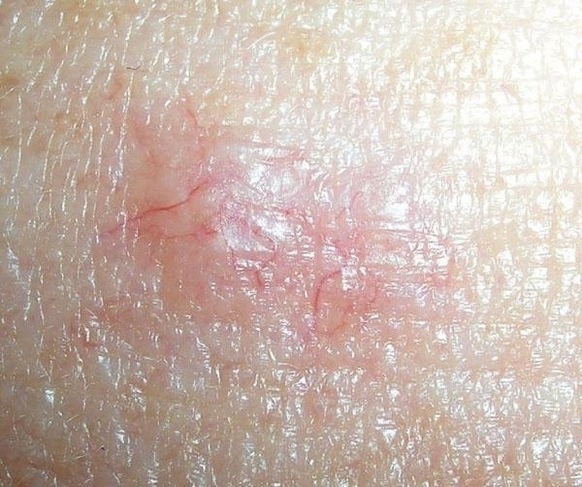
Basal cell carcinoma is the most common and least serious type of nonmelanoma cancer, accounting for more than 95% of cases. This type of cancer starts in the basal cells that are located in the deepest layer of the skin.
Basal cell carcinoma emerges as a bright pink spot on the skin that is slow growing. It may have a crust in the center and bleed easily.
Basal cell carcinoma is more common in people with light skin over the age of 40 due to lifelong sun exposure.
Location: basal cell carcinomas are almost always found in areas with a great deal of sun exposure, like the face, neck, ears, or scalp, but can also pop up in other areas of the body.
What to do: it is important to consult a dermatologist for any lesions that are suspicious for basal cell carcinoma. A dermatologist can confirm the diagnosis and recommend the best treatment, which typically involves a small surgery or laser treatments to remove the lesion and eliminate all of the affected cells.
2. Squamous cell carcinoma
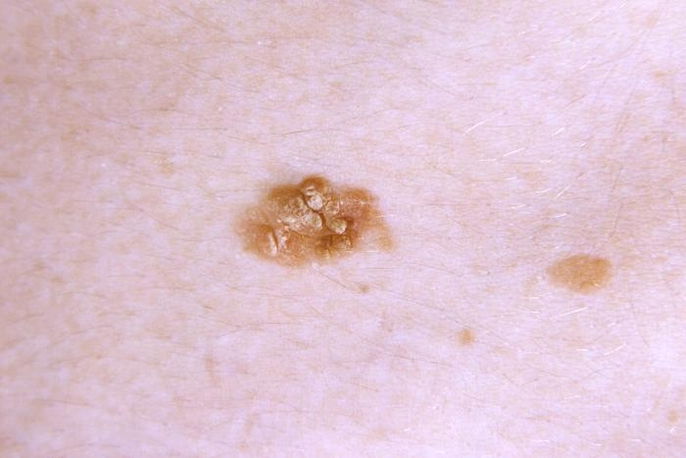
Squamous cell carcinoma is the second most common type of nonmelanoma skin cancer and is derived from squamous cells that make up the most superficial layer of the skin.
This type of cancer appears as a reddish lump on the skin or as a sore that flakes and forms a scab or looks like a wart.
Squamous cell carcinoma is more common in men, however it can also develop in women and people of any age, especially those with light skin, hair, and eyes. This is due to a lack of melanin that protects the skin against ultraviolet (UV) rays.
Sun exposure is the main risk factor for this type of cancer, however it can also occur in people who have been treated with chemotherapy and radiation or have chronic skin problems like poor wound healing.
Location: squamous cell carcinomas can arise on any part of the body but more commonly occur in areas of the skin that are exposed to the sun, such as the scalp, hands, lips, or neck, and that show signs of sun damage like loss of elasticity, wrinkles, or color changes.
What to do: as with other types of suspicious lesions, it is important to consult a dermatologist to confirm a diagnosis and begin the best treatment. Squamous cell carcinomas are typically treated with a small surgery or other technique, such as cryotherapy (freezing), to remove the majority of the affected cells. Radiation may be needed following removal of the lesion to eliminate any remaining cancer cells.
3. Merkel cell carcinoma
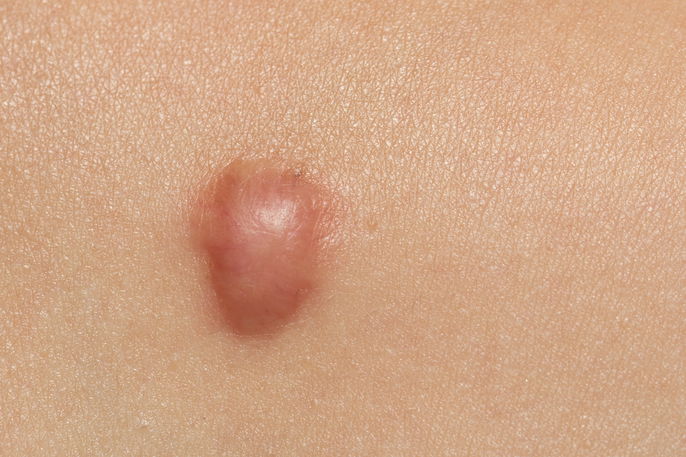
Merkel cell carcinoma is a less common type of nonmelanoma skin cancer that occurs more often in older adults due to prolonged sun exposure throughout their lives, as well as in people with a weak immune system.
This type of cancer typically appears as a painless lump on the skin that is reddish-blue in color. It is more common on the face, head, and neck and tends to grow and spread rapidly to other parts of the body.
Location: Merkel cell carcinomas typically arise on the face, head, or neck, but can also develop on other parts of the body, even in areas not exposed to the sun.
What to do: consult a dermatologist if you notice a lump or spot that is changing in size, shape, or color; is growing rapidly; or bleeds easily from only light trauma, such as washing the skin or shaving.
A dermatologist can examine the skin and recommend the best treatment, which may involve surgery, radiation, immunotherapy, or chemotherapy.
4. Malignant melanoma
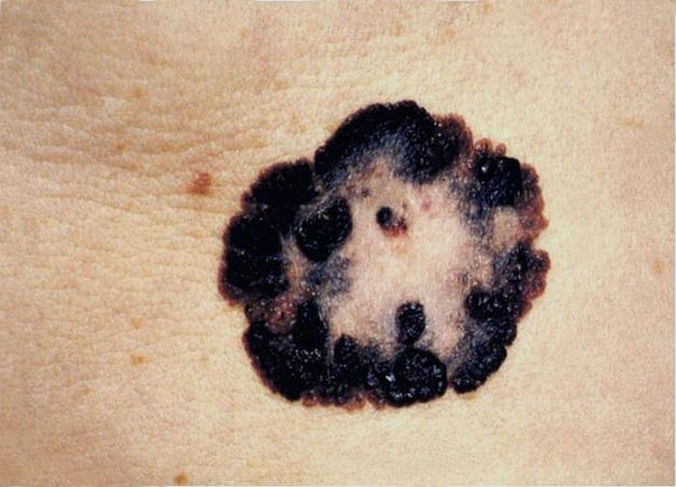
Malignant melanoma is the most dangerous type of skin cancer and usually appears as a dark spot on the skin that becomes more deformed over time. Malignant melanoma can be fatal if not identified early on, as it can develop rapidly and spread to other organs of the body like the lungs.
Location: melanoma frequently develops in areas of the body that are exposed to the sun, such as the face, shoulders, scalp, and ears, especially in people with very light skin.
Read more about what melanoma looks like.
What to do: because this type of skin cancer has a higher cure rate when caught and treated early, it is important to consult a dermatologist for any dark spots on the skin that are increasing in size over time or have an irregular shape. Treatment for most cases of melanoma starts with a surgery to remove the majority of affected cells, followed by radiation or chemotherapy to eliminate the remaining cancer cells.
5. Skin sarcomas
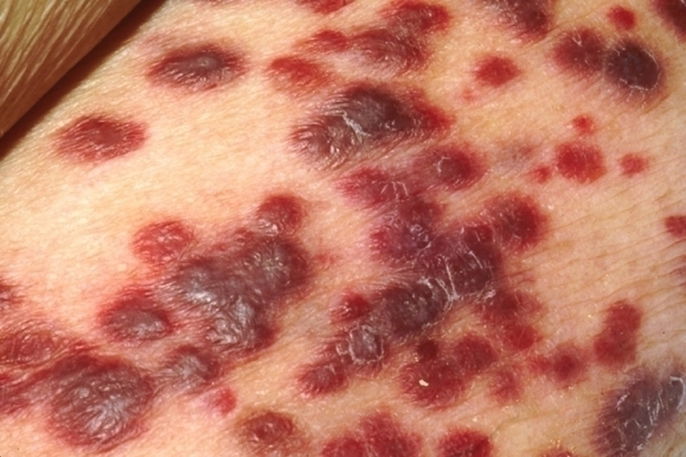
Skin sarcomas are a type of malignant skin cancer that affects the deepest layers of the skin. These include Kaposi sarcoma and dermatofibrosarcoma protuberans (DFSP).
DFSP can occur spontaneously due to genetic factors or skin trauma, and can emerge in areas of previous injury like surgical scars or burns, while Kaposi sarcoma is caused by an infection by the Kaposi sarcoma-associated herpesvirus(KSHV), also known as human herpesvirus-8 (HHV8).
DFSP is more common in young men, but can also occur in women. It appears as a red or purple spot on the skin and may resemble a pimple, scar, or birthmark. In more advanced stages, wounds may form at the tumor site and bleeding or necrosis of the affected skin can occur.
Kaposi sarcoma is more common in people with weakened immune systems, such as people who are recipients of an organ transplant or are living with HIV or HHV-8. This type of tumor appears as purplish-red spots on the skin that can affect the whole body.
Location: skin sarcomas are more common on the trunk, head, neck, legs, and arms, and may rarely affect the genital area.
What to do: consult a dermatologist for any red spots or lesions that appear on the skin so that an accurate diagnosis can be made. Skin sarcomas are an aggressive form of cancer that can spread to other parts of the body and should be treated with surgery, radiation, or molecular therapy. People with HIV, who are at higher risk for skin sarcomas, should be seen regularly by their healthcare team and take medication to help control the disease.






























